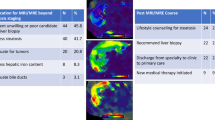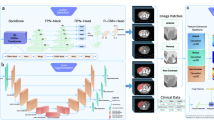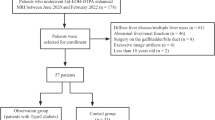Abstract
The role of diagnostic imaging in the assessment of liver disease continues to gain in importance. The classic techniques used for liver imaging are ultrasonography, CT and MRI. In the past decade, there have been significant advances in all three techniques. In this article, we discuss the advances in ultrasonography, CT and MRI that have improved assessment of focal and diffuse liver disease, including the development of hardware, software, processing algorithms and procedural innovations.
Key Points
-
The accuracy of ultrasonography, CT and MRI for the detection and characterization of focal and diffuse liver disease has been markedly improved by technical innovations in the past decade
-
Improvements in gray-scale ultrasonography (such as tissue harmonic imaging) and the introduction of contrast ultrasonography have been the technical mainstay of advances in this field
-
The major development for CT has been the introduction of multidetector helical technology—a prerequisite for fast acquisition of high-resolution images that also provides the option for high-quality image reformations in arbitrary planes
-
Advances in MRI have been even more significant than those in ultrasonography and CT, and include the introduction of rapid, high-resolution imaging, the adoption of magnetic resonance spectroscopy and diffusion-weighted imaging, as well as the development of cell-specific contrast agents
This is a preview of subscription content, access via your institution
Access options
Subscribe to this journal
Receive 12 print issues and online access
$209.00 per year
only $17.42 per issue
Buy this article
- Purchase on Springer Link
- Instant access to full article PDF
Prices may be subject to local taxes which are calculated during checkout








Similar content being viewed by others
References
Starritt HC et al. (1986) The development of harmonic distortion in pulsed finite-amplitude ultrasound passing through liver. Phys Med Biol 31: 1401–1409
Sodhi KS et al. (2005) Role of tissue harmonic imaging in focal hepatic lesions: comparison with conventional sonography. J Gastroenterol Hepatol 20: 1488–1493
Choudhry S et al. (2000) Comparison of tissue harmonic imaging with conventional US in abdominal disease. Radiographics 20: 1127–1135
Hann LE et al. (1999) Hepatic sonography: comparison of tissue harmonic and standard sonography techniques. AJR Am J Roentgenol 173: 201–206
Jang HJ et al. (2000) Ultrasonographic evaluation of focal hepatic lesions: comparison of pulse inversion harmonic, tissue harmonic, and conventional imaging techniques. J Ultrasound Med 19: 293–299
Albrecht T et al. (2004) Guidelines for the use of contrast agents in ultrasound. Ultraschall Med 25: 249–256
Harvey CJ et al. (2000) Pulse-inversion mode imaging of liver specific microbubbles: improved detection of subcentimetre metastases. Lancet 355: 807–808
Dietrich CF et al. (2006) Assessment of metastatic liver disease in patients with primary extrahepatic tumors by contrast-enhanced sonography versus CT and MRI. World J Gastroenterol 12: 1699–1705
Konopke R et al. (2007) Contrast-enhanced ultrasonography to detect liver metastases: a prospective trial to compare transcutaneous unenhanced and contrast-enhanced ultrasonography in patients undergoing laparotomy. Int J Colorectal Dis 22: 201–207
Therasse P et al. (2000) New guidelines to evaluate the response to treatment in solid tumors. European Organization for Research and Treatment of Cancer, National Cancer Institute of the United States, National Cancer Institute of Canada. J Natl Cancer Inst 92: 205–216
Leen E et al. (2006) Potential value of contrast-enhanced intraoperative ultrasonography during partial hepatectomy for metastases: an essential investigation before resection? Ann Surg 243: 236–240
Dietrich CF et al. (2004) Improved characterisation of histologically proven liver tumours by contrast enhanced ultrasonography during the portal venous and specific late phase of SHU 508A. Gut 53: 401–405
Nicolau C et al. (2006) Importance of evaluating all vascular phases on contrast-enhanced sonography in the differentiation of benign from malignant focal liver lesions. AJR Am J Roentgenol 186: 158–167
Schlottmann K et al. (2004) Contrast-enhanced ultrasound allows for interventions of hepatic lesions which are invisible on convential B-mode. Z Gastroenterol 42: 303–310
Strobel D et al. (2005) Contrast-enhanced sonography for the characterisation of hepatocellular carcinomas—correlation with histological differentiation. Ultraschall Med 26: 270–276
Blomley MJ et al. (1998) Liver vascular transit time analyzed with dynamic hepatic venography with bolus injections of an US contrast agent: early experience in seven patients with metastases. Radiology 209: 862–866
Bernatik T et al. (2004) Hepatic transit time of an echo enhancer: an indicator of metastatic spread to the liver. Eur J Gastroenterol Hepatol 16: 313–317
Albrecht T et al. (1999) Non-invasive diagnosis of hepatic cirrhosis by transit-time analysis of an ultrasound contrast agent. Lancet 353: 1579–1583
Blomley MJ et al. (2003) Liver microbubble transit time compared with histology and Child–Pugh score in diffuse liver disease: a cross-sectional study. Gut 52: 1188–1193
Zhou X et al. (2005) Hepatic transit time: indicator of the therapeutic response to radiofrequency ablation of liver tumours. Br J Radiol 78: 433–436
Prokop M (2003) Multislice CT: technical principles and future trends. Eur Radiol 13 (Suppl 5): M3–M13
Schima W et al. (2005) Multidetector computed tomography of the liver [German]. Radiologe 45: 15–23
Kopka L et al. (1996) Dual-phase helical CT of the liver: effects of bolus tracking and different volumes of contrast material. Radiology 201: 321–326
Semelka RC et al. (2001) Focal liver lesions: comparison of dual-phase CT and multisequence multiplanar MR imaging including dynamic gadolinium enhancement. J Magn Reson Imaging 13: 397–401
Scott DJ et al. (2001) Dual phase helical CT versus portal venous phase CT for the detection of colorectal liver metastases: correlation with intra-operative sonography, surgical and pathological findings. Clin Radiol 56: 235–242
Semelka RC and Helmberger TK (2001) Contrast agents for MR imaging of the liver. Radiology 218: 27–38
Han JK et al. (2002) Cholangiocarcinoma: pictorial essay of CT and cholangiographic findings. Radiographics 22: 173–187
Kim SH et al. (2005) Ferucarbotran-enhanced MRI versus triple-phase MDCT for the preoperative detection of hepatocellular carcinoma. AJR Am J Roentgenol 184: 1069–1076
Kim YK et al. (2006) Hepatocellular carcinoma in patients with chronic liver disease: comparison of SPIO-enhanced MR imaging and 16-detector row CT. Radiology 238: 531–541
Kang BK et al. (2003) Preoperative depiction of hepatocellular carcinoma: ferumoxides-enhanced MR imaging versus triple-phase helical CT. Radiology 226: 79–85
Hori M et al. (2002) Detection of hypervascular hepatocellular carcinoma: comparison of SPIO-enhanced MRI with dynamic helical CT. J Comput Assist Tomogr 26: 701–710
Kinkel K et al. (2002) Detection of hepatic metastases from cancers of the gastrointestinal tract by using noninvasive imaging methods (US, CT, MR imaging, PET): a meta-analysis. Radiology 224: 748–756
Ward J et al. (1999) Hepatic lesion detection: comparison of MR imaging after the administration of superparamagnetic iron oxide with dual-phase CT by using alternative-free response receiver operating characteristic analysis. Radiology 210: 459–466
Robinson PJ (2000) Imaging liver metastases: current limitations and future prospects. Br J Radiol 73: 234–241
Winterer J et al. (2006) Detection and characterization of benign focal liver lesions with multislice CT. Eur Radiol 16: 2427–2443
Bitschnau S et al. (2004) CT-angiography with a 16-row CT scanner for perioperative evaluation of the hepatic arteries [German]. Rofo 176: 1634–1640
Guven K and Acunas B (2004) Multidetector computed tomography angiography of the abdomen. Eur J Radiol 52: 44–55
Atasoy C and Akyar S (2004) Multidetector CT: contributions in liver imaging. Eur J Radiol 52: 2–17
Hamer OW et al. (2005) Imaging features of perivascular fatty infiltration of the liver: initial observations. Radiology 237: 159–169
Limanond P et al. (2004) Macrovesicular hepatic steatosis in living related liver donors: correlation between CT and histologic findings. Radiology 230: 276–280
Ricci C et al. (1997) Noninvasive in vivo quantitative assessment of fat content in human liver. J Hepatol 27: 108–113
Cheng Y et al. (2001) Assessment of donor fatty livers for liver transplantation. Transplantation 71: 1206–1207
Giacomuzzi SM et al. (2001) Radiation exposure in single slice and multi-slice spiral CT (a phantom study) [German]. Rofo 173: 643–649
Kalra MK et al. (2003) Multislice CT: update on radiation and screening. Eur Radiol 13 (Suppl 5): M129–M133
Hundt W et al. (2005) Dose reduction in multislice computed tomography. J Comput Assist Tomogr 29: 140–147
Petsch R et al. (1999) New techniques and pulse sequences in MRI of the liver [German]. Radiologe 39: 662–670
McKenzie CA et al. (2004) Shortening MR image acquisition time for volumetric interpolated breath-hold examination with a recently developed parallel imaging reconstruction technique: clinical feasibility. Radiology 230: 589–594
Dobritz M et al. (2002) VIBE with parallel acquisition technique—a novel approach to dynamic contrast-enhanced MR imaging of the liver [German]. Rofo 174: 738–741
Zech CJ et al. (2004) Modern visualization of the liver with MRT. Current trends and future perspectives [German]. Radiologe 44: 1160–1169
Ito K et al. (1999) MR imaging of the liver: techniques and clinical applications. Eur J Radiol 32: 2–14
Rofsky NM et al. (1999) Abdominal MR imaging with a volumetric interpolated breath-hold examination. Radiology 212: 876–884
Lee VS et al. (2000) Hepatic MR imaging with a dynamic contrast-enhanced isotropic volumetric interpolated breath-hold examination: feasibility, reproducibility, and technical quality. Radiology 215: 365–372
Sodickson A et al. (2006) Three-dimensional fast-recovery fast spin-echo MRCP: comparison with two-dimensional single-shot fast spin-echo techniques. Radiology 238: 549–559
Wallnoefer AM et al. (2005) Comparison of 2D and 3D sequences for MRCP. Clinical value of the different techniques [German]. Radiologe 45: 993–1003
Katayama M et al. (2001) Fat-suppressed T2-weighted MRI of the liver: comparison of respiratory-triggered fast spin-echo, breath-hold single-shot fast spin-echo, and breath-hold fast-recovery fast spin-echo sequences. J Magn Reson Imaging 14: 439–449
Zech CJ et al. (2004) High-resolution MR-imaging of the liver with T2-weighted sequences using integrated parallel imaging: comparison of prospective motion correction and respiratory triggering. J Magn Reson Imaging 20: 443–450
Colagrande S et al. (2006) Magnetic resonance diffusion-weighted imaging: extraneurological applications. Radiol Med (Torino) 111: 392–419
Koinuma M et al. (2005) Apparent diffusion coefficient measurements with diffusion-weighted magnetic resonance imaging for evaluation of hepatic fibrosis. J Magn Reson Imaging 22: 80–85
Naganawa S et al. (2005) Diffusion-weighted imaging of the liver: technical challenges and prospects for the future. Magn Reson Med Sci 4: 175–186
Koh DM et al. (2006) Colorectal hepatic metastases: quantitative measurements using single-shot echo-planar diffusion-weighted MR imaging. Eur Radiol 16: 1898–905
Sun XJ et al. (2005) Quantitative evaluation of diffusion-weighted magnetic resonance imaging of focal hepatic lesions. World J Gastroenterol 11: 6535–6537
Solga SF et al. (2005) Hepatic 31P magnetic resonance spectroscopy: a hepatologist's user guide. Liver Int 25: 490–500
Khan SA et al. (2005) In vivo and in vitro nuclear magnetic resonance spectroscopy as a tool for investigating hepatobiliary disease: a review of H and P MRS applications. Liver Int 25: 273–281
Longo R et al. (1993) Fatty infiltration of the liver. Quantification by 1H localized magnetic resonance spectroscopy and comparison with computed tomography. Invest Radiol 28: 297–302
Thomsen C et al. (1994) Quantification of liver fat using magnetic resonance spectroscopy. Magn Reson Imaging 12: 487–495
Qayyum A et al. (2005) Accuracy of liver fat quantification at MR imaging: comparison of out-of-phase gradient-echo and fat-saturated fast spin-echo techniques—initial experience. Radiology 237: 507–511
Hussain HK et al. (2005) Hepatic fat fraction: MR imaging for quantitative measurement and display—early experience. Radiology 237: 1048–1055
Rinella ME et al. (2003) Dual-echo, chemical shift gradient-echo magnetic resonance imaging to quantify hepatic steatosis: implications for living liver donation Liver Transpl 9: 851–856
Mortele KJ and Ros PR (2001) Imaging of diffuse liver disease. Semin Liver Dis 21: 195–212
Alustiza JM et al. (2004) MR quantification of hepatic iron concentration. Radiology 230: 479–484
Gandon Y et al. (2004) Non-invasive assessment of hepatic iron stores by MRI. Lancet 363: 357–362
Ba-Ssalamah A et al. (2004) MRT of the liver. Clinical significance of nonspecific and liver-specific MRT contrast agents [German]. Radiologe 44: 1170–1184
Braga L et al. (2004) Modern hepatic imaging. Surg Clin North Am 84: 375–400
Tanimoto A and Kuribayashi S (2006) Application of superparamagnetic iron oxide to imaging of hepatocellular carcinoma. Eur J Radiol 58: 200–216
Bluemke DA et al. (2000) Detection of hepatic lesions in candidates for surgery: comparison of ferumoxides-enhanced MR imaging and dual-phase helical CT. AJR Am J Roentgenol 175: 1653–1658
Tanimoto A et al. (2005) Superparamagnetic iron oxide-enhanced MR imaging for focal hepatic lesions: a comparison with CT during arterioportography plus CT during hepatic arteriography. J Gastroenterol 40: 371–380
Choi D et al. (2001) Preoperative detection of hepatocellular carcinoma: ferumoxides-enhanced MR imaging versus combined helical CT during arterial portography and CT hepatic arteriography. AJR Am J Roentgenol 176: 475–482
Kwak HS et al. (2005) Detection of hepatocellular carcinoma: comparison of ferumoxides-enhanced and gadolinium-enhanced dynamic three-dimensional volume interpolated breath-hold MR imaging. Eur Radiol 15: 140–147
Kwak HS et al. (2004) Preoperative detection of hepatocellular carcinoma: comparison of combined contrast-enhanced MR imaging and combined CT during arterial portography and CT hepatic arteriography. Eur Radiol 14: 447–457
Kim YK et al. (2006) Comparison of gadobenate dimeglumine-enhanced dynamic MRI and 16-MDCT for the detection of hepatocellular carcinoma. AJR Am J Roentgenol 186: 149–157
Stoker J et al. (2002) Prospective comparative study of spiral computed tomography and magnetic resonance imaging for detection of hepatocellular carcinoma. Gut 51: 105–107
Huppertz A et al. (2005) Enhancement of focal liver lesions at gadoxetic acid-enhanced MR imaging: correlation with histopathologic findings and spiral CT—initial observations. Radiology 234: 468–478
Stroszczynski C et al. (2004) Current status of MRI diagnostics with liver-specific contrast agents. Gd-EOB-DTPA and Gd-BOPTA [German]. Radiologe 44: 1185–1191
Reimer P et al. (2004) Hepatobiliary contrast agents for contrast-enhanced MRI of the liver: properties, clinical development and applications. Eur Radiol 14: 559–578
Bollow M et al. (1997) Gadolinium-ethoxybenzyl-DTPA as a hepatobiliary contrast agent for use in MR cholangiography: results of an in vivo phase-I clinical evaluation. Eur Radiol 7: 126–132
Huppertz A et al. (2004) Improved detection of focal liver lesions at MR imaging: multicenter comparison of gadoxetic acid-enhanced MR images with intraoperative findings. Radiology 230: 266–275
Carlos RC et al. (2002) Gadolinium-ethoxybenzyl-diethylenetriamine pentaacetic acid as an intrabiliary contrast agent: preliminary assessment. AJR Am J Roentgenol 179: 87–92
Ryeom HK et al. (2004) Quantitative evaluation of liver function with MRI using Gd-EOB-DTPA. Korean J Radiol 5: 231–239
Vitellas KM et al. (2001) Cirrhosis: spectrum of findings on unenhanced and dynamic gadolinium-enhanced MR imaging. Abdom Imaging 26: 601–615
Ward J et al. (2000) Hepatocellular carcinoma in the cirrhotic liver: double-contrast MR imaging for diagnosis. Radiology 216: 154–162
Bhartia B et al. (2003) Hepatocellular carcinoma in cirrhotic livers: double-contrast thin-section MR imaging with pathologic correlation of explanted tissue. AJR Am J Roentgenol 180: 577–584
Halavaara J et al. (2002) Efficacy of sequential use of superparamagnetic iron oxide and gadolinium in liver MR imaging. Acta Radiol 43: 180–185
Author information
Authors and Affiliations
Corresponding author
Ethics declarations
Competing interests
The authors declare no competing financial interests.
Rights and permissions
About this article
Cite this article
Hamer, O., Schlottmann, K., Sirlin, C. et al. Technology Insight: advances in liver imaging. Nat Rev Gastroenterol Hepatol 4, 215–228 (2007). https://doi.org/10.1038/ncpgasthep0766
Received:
Accepted:
Issue Date:
DOI: https://doi.org/10.1038/ncpgasthep0766
This article is cited by
-
Motion model ultrasound localization microscopy for preclinical and clinical multiparametric tumor characterization
Nature Communications (2018)



